Today we’re preparing a Garlic and Herb Prime Rib recipe, and this post is Your Guide to a Perfect Roast. For me, the perfect prime rib features a moist and juicy interior, with a savory crust, rich with plenty of garlic, plenty of herbs, and just a hint of heat. And today’s roast checks all of those boxes.
This garlic herb prime rib roast is the kind of recipe you serve as the main course for a special occasion, holiday meal or fancy dinner party, and pairs perfectly with all the usual sides. Think creamy mashed potatoes, stuffing, garlic bread, or roasted vegetables. Best of all, this is what I would consider to be an easy prime rib recipe, as the cooking methods employed are deliciously simple – just mix the garlic and herbs, rub that over the meat, and set it to cook in the oven.
If this sounds like the perfect prime rib for you, especially for the holiday season, then read on. Below, I’ll provide you with a complete ingredient checklist, a printable recipe card, tips for success in preparing this prime rib, and the temperature ranges for best results for every preferred level of doneness.
Now, without further introduction, let’s get to it.
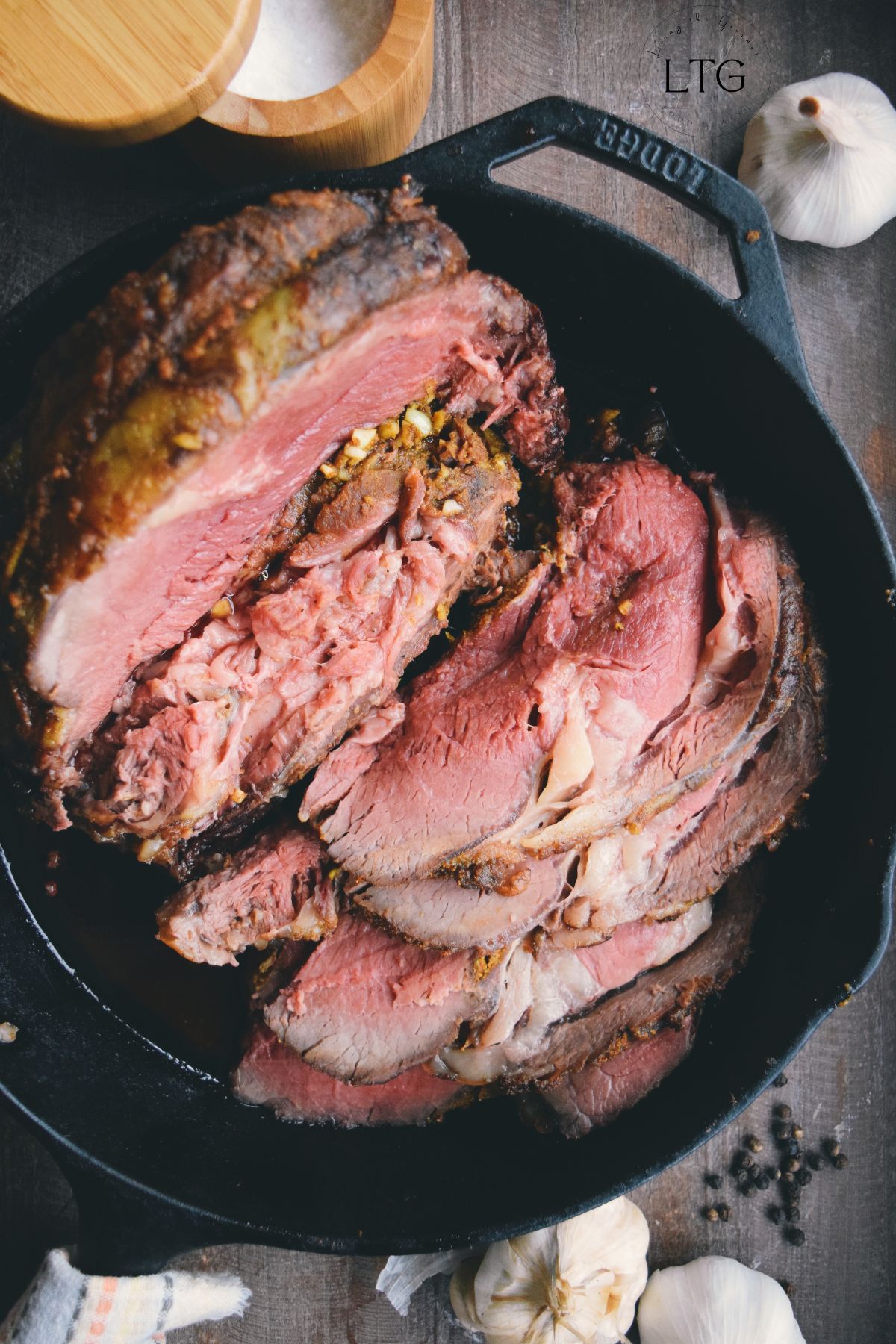
Garlic and Herb Prime Rib – Recipe Overview
All right, if you’ve made it this far, my Garlic Herb Prime Rib recipe has likely caught your attention. While this recipe incorporates a medley of spices like cayenne, cumin, and Jamaican curry to bring both depth of flavor and background heat, and while the delicious garlic and herb crust locks in flavor, you probably still have a few questions.
Maybe you’re wondering what this recipe is like in terms of taste or texture, or perhaps you’re wondering what the cooking method is like for this recipe, or how hard this recipe is to preparing. Or maybe you have questions regarding the proper seasoning, resting, and slow roasting that we use to achieve a juicy, tender cut of beef.
For the answer to those questions and more, read on.
Taste and Texture: The meat cooks up with a smoky, subtly spicy flavor, with rich herbal aromatics courtesy of the spice rub. The beef’s marbling combines with the herbs and olive oil to create a beautiful, beefy crust, while sealing in the meat’s juices. These qualities combine to ensure a juicy, tender interior with a crisp, flavorful outer crust.
Difficulty Level: Beginner to Intermediate: The recipe is overall fairly simple. Combine the spice rub, then rub the meat down. However, handling large hinds of raw meat can be intimidating for beginner home chefs, while proper temperature control and resting time require some attention to detail. Overall, I’ll say this recipe is right on the border between “beginner friendly” and “intermediate” difficulty.
Prep Time
- 10 Minutes: for seasoning and prepping the meat.
- Resting Time: There are ‘two’ resting periods involved in preparing the meat. The first is directly after you’ve seasoned the meat. You want to allow at least 15 minutes before roasting for the seasonings to seep into and permeate the meat, or even up to overnight for deeper flavor.
Recipe Prep Process for our Garlic and Herb Prime Rib
- Make the spice rub: Simply combine the seasonings, fresh garlic, and olive oil.
- Prepare the meat: We do this by making small slits along the meat as directed in the recipe card, and then massaging the rub into the prime rib, being sure to pack the seasonings into the slits.
- Let it rest: After seasoning, let the meat rest for at least 15 minutes or refrigerate overnight.
- Roast in the oven at 325°F: Plan for about 17-20 minutes per pound for desired doneness. Again, consult the recipe card below for complete instructions.
- Rest the roast for 15-20 minutes before slicing to lock in juices. Do not skip this step, otherwise the juices will leak out of the roast, drying it out.
Pairings for our Garlic and Herb Prime Rib
- Sauces: Serve with the natural pan juices, an au jus sauce, garlic butter or a classic horseradish sauce for extra zing.
- Side Dishes:
- Potatoes: Garlic mashed potatoes or roasted potatoes for a hearty side.
- Greens: Sautéed greens (like spinach or Brussels sprouts) to balance the richness.
- Creamy risotto or Yorkshire pudding for a classic steakhouse touch.
- Wine Pairings: A bold Cabernet Sauvignon or Syrah complements the deep flavors of the beef. See our red wine guide for a more in depth overview.
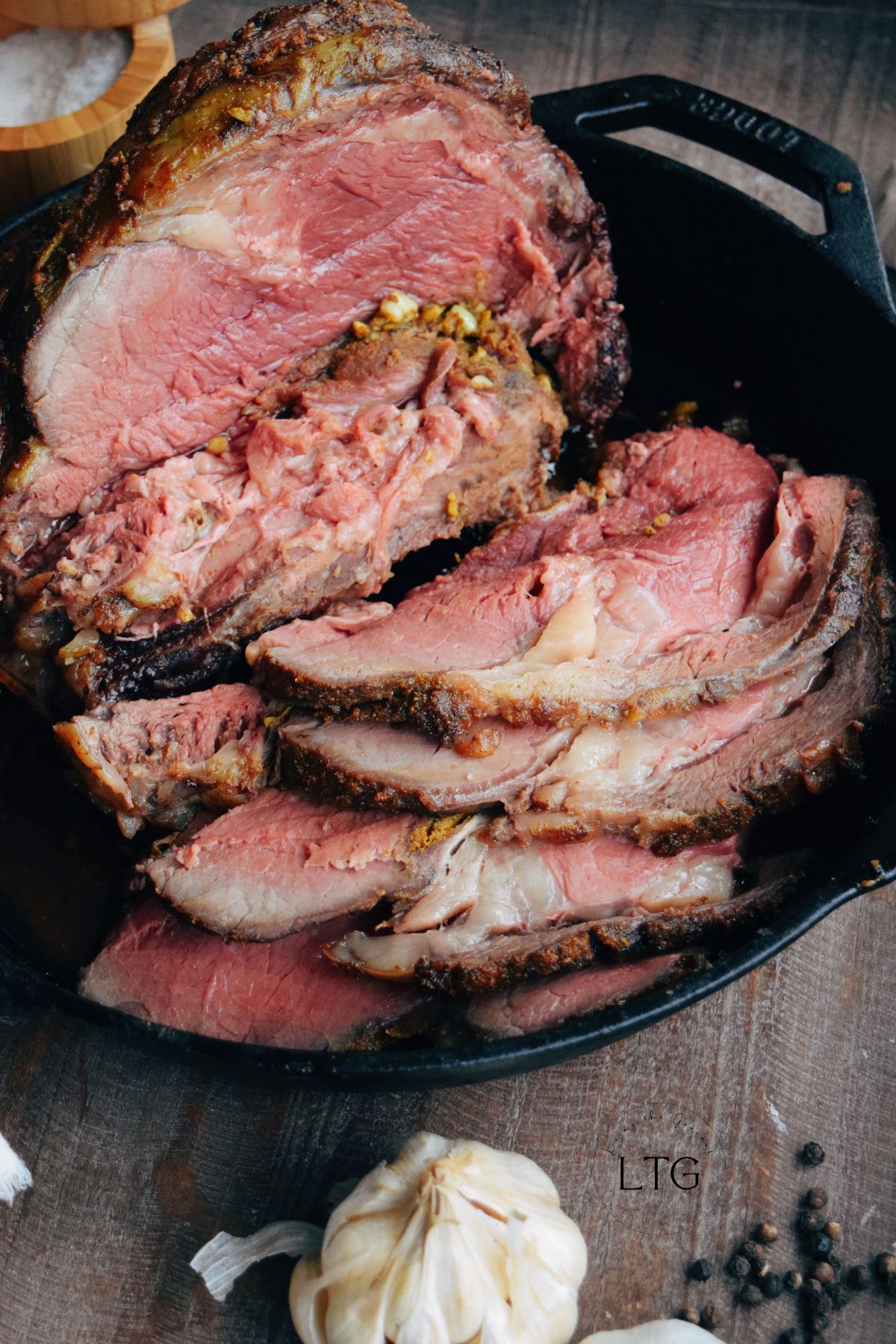
Choosing the Best Prime Rib – A Brief Guide
Any good beef recipe starts with selecting the right beef for the job - and today's Garlic Herb Prime Rib recipe is no exception. In this case, that means selecting a good prime rib is essential for achieving a juicy, flavorful roast, one that perfectly balances tenderness, marbling, and richness.
But how to select such a prime rib?
Here’s my brief guide on what to look for when buying your next prime rib:
Bone-in vs. Boneless: Which is Better and Why?
- Bone-in Prime Rib: This is my go-to, and it should be yours too, since the bone acts as a natural insulator, meaning it helps the meat retain moisture, thereby developing a deeper flavor through the course of the roasting process. This also means that the bone helps ensure a more even cooking process, thereby preventing overcooking.
- Boneless Prime Rib: Easier to slice, easier to serve, and generally cooks faster. However, this also means that boneless prime ribs require extra attention as they tend to go from ‘moist and juicy’ to ‘woefully overcooked’ in what feels like no time at all. To help mitigate this, I suggest tying the roast with butcher’s twine to maintain its shape during cooking, and thereby facilitate more even roasting.
The Best Choice: For me personally, there’s almost no situation in which I would opt for a boneless roast when given the option of a bone-in roast (also called a standing rib roast). Personally, I think the bone-in roast offers the best balance of flavor and juiciness, making it the ideal pick for a classic prime rib roast dinner. Unless you are seriously pressed for time, or unless the boneless option has been discounted meaning you can save a few dollars, I would always opt for the bone-in roast.
USDA Prime vs. Choice vs. Select: Why It Matters
The first thing to look for is the meat’s grade. Even if you prepare my Garlic Herb Prime Rib recipe perfectly, it won't matter if the quality of the meat is poor. Here in the US, the USDA grading system is based on the meat’s marbling (fat content), the animal’s age, firmness, texture, and ‘overall quality.’ But what exactly does that mean?
To answer that, here’s a breakdown of each grade:
- USDA Prime: As the name implies, this is where you find prime cuts. This represents the highest grade of meat. These cuts offer the most marbling, resulting in superior flavor, tenderness, and juiciness. Best for special occasions and premium results.
- USDA Choice: Still a great option. These cuts offer moderate marbling, but still enough to deliver good flavor and tenderness, but at a more affordable price.
- USDA Select: The leanest option with minimal marbling. While these cuts can certainly still give you a flavorful roast or steak, they often lack the richness of Prime or Choice options, and may require extra seasoning, butter basting, or slow roasting to avoid dryness.
Best Choice: It shouldn’t come as any surprise that USDA Prime is ideal if looking purely for best results regardless of price. However, USDA Choice is still an excellent option, especially for those looking for more budget-friendly alternative.
What to Ask Your Butcher for the Best Cut
My usual answer to this is “nothing.” I’ve said it many times before – only pester your butcher if you’re on decent terms with them, and if you trust the establishment where they work to provide quality meat. Otherwise, it’s best to navigate the meat case on your own, only stopping to ask questions if absolutely necessary (such as if you don’t see what you’re looking for, or have a question about pricing).
That said, if you are on decent terms with your butcher, or trust the establishment where they’re working, here’s what to ask to ensure you’re getting the best quality:
- Ask for a "standing rib roast": If you want a bone-in cut, don’t leave it to chance and ask for a standing rib roast. For best presentation, request it trimmed and frenched (meaning they remove excess fat and expose the bones).
- Request the “center-cut”: This means asking for ribs #6-9, as these sections have the best marbling and tenderness. Remember, fat is flavor, because fat is moisture.
- If buying boneless, ask for it to be tied: Tying it with butcher twine ensures that the meat maintains its shape, even through a lengthy roasting process.
- For the perfect portion size, plan for 1 pound per person, or a pound and half, per person.
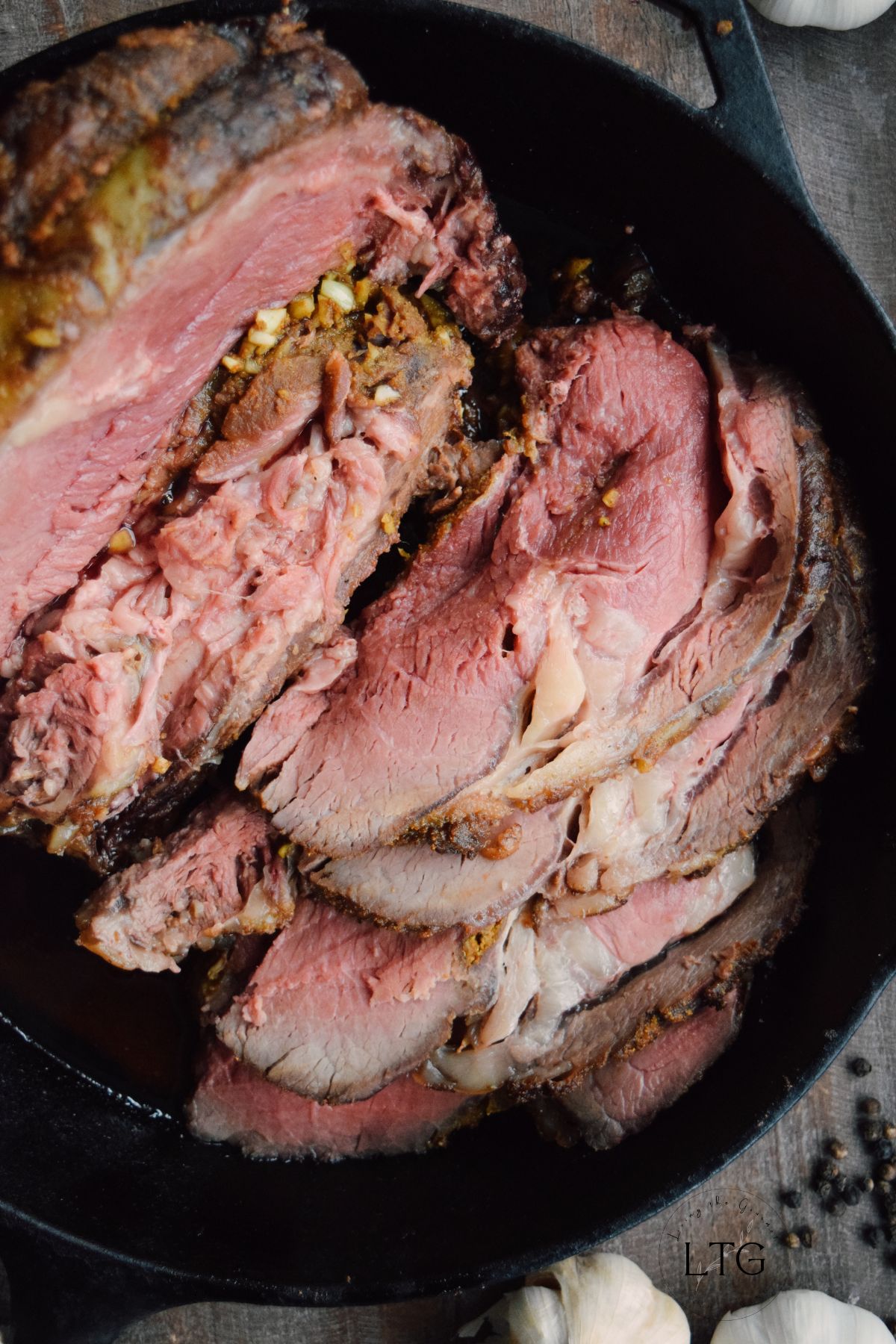
Garlic Herb Prime Rib Recipe - Ingredient Checklist
For the Prime Rib Roast:
- 3-4 lb. Prime Rib
- How Much to Buy? While I’m of the opinion that you can never have too much prime rib, I would generally advise about a pound of prime rib per person, the same as any other beef roast.
- Bone-In Or Boneless? I do wholeheartedly suggest using a bone-in rib roast for this recipe, as it really does make a difference for both flavor and moisture. The rib bones act as a natural rack, helping the meat cook evenly. This is not a recipe for using a boneless roast.
- Tips: If using a boneless cut, adjust cooking time slightly as it tends to cook faster.
- Substitutions: A boneless rib roast can work for this recipe, as does a rack of lamb, or a beef tenderloin. That said, I do recommend using a classic bone-in prime rib roast.
- Salt
- Notes: Helps bring out the natural flavors of the meat.
- Tips: I recommend using a large grain salt, such as sea salt or kosher salt. That said, plain table salt will get the job done.
- Freshly Cracked Black Pepper
- Fresher Is Better: Fresh cracked black pepper has the best aromatics, and a little black pepper goes a long way in balancing out the natural richness of the roast, while enhancing the overall aromatic profile.
- Bonus Points: Crushing the pepper in a mortar and pestle will give you the absolute best results, so bonus points for that. Yes, this absolutely does make a difference, as it ensures maximal release of the peppercorns’ natural oils.
For the Rub
- 1 tsp. Cayenne Pepper
- Tip: We’re not looking at searing heat here, but more of a subtle warmth. Increase or decrease based on your preference.
- Substitution: Smoked paprika, chili powder, or even fresh diced chilis can all work.
- 1 tsp. Garlic Powder
- Tip: Helps to enhance the meat’s savory profile, while also adding garlicy goodness. Do not substitute with garlic salt. That will make the meat unpalatably salty. Again, no garlic salt. That is ‘not’ a substitute for garlic powder in this recipe.
- Why Not Fresh? Because we’re looking for optimal distribution through the rub, and garlic powder helps achieve this.
- If Using Fresh: If you prefer fresh, for a brighter, more pungent garlicy bite, I would suggest crushing and then dicing the garlic, or even grating the garlic, to ensure maximal release of the juices, which help achieve even distribution.
- 1 tsp. Jamaican Curry
- Tip: For added warmth and savory depth. Do double check the sell by date, as this particular spice mix ‘does’ have a shelf life.
- Substitution: Your curry of choice should work just fine.
- 1 tsp. Cumin
- Tip: A key ingredient for this rub. Cumin an brings earthy undertone to the mix that are hard to replicate with other spices.
- Bonus Points: Fresh ground cumin for the best aromatics.
- 1 tsp. Salt
- Tip: As mentioned above, use kosher or sea salt for better absorption into the meat.
- 1 tsp. Coriander
- Tip: Provides a light, citrusy note to the rub.
- Bonus Points: Grind whole coriander seeds for maximum freshness and aromatic goodness.
- 3 Cloves of Fresh Garlic, Finely Chopped
- Tip: Fresh garlic infuses more potent flavor compared to pre-minced varieties.
- Substitution: Use 1 teaspoon garlic paste if fresh garlic is unavailable.
- 3 tbsp. Olive Oil
- Tip: Helps the rub adhere to the meat and promotes even browning.
- Substitution: Avocado oil is a great alternative for a higher smoke point.
Optional
- Natural Pan Juices (for serving)
- Tip: Deglaze the pan with a splash of red wine or beef stock for a quick and flavorful au jus.
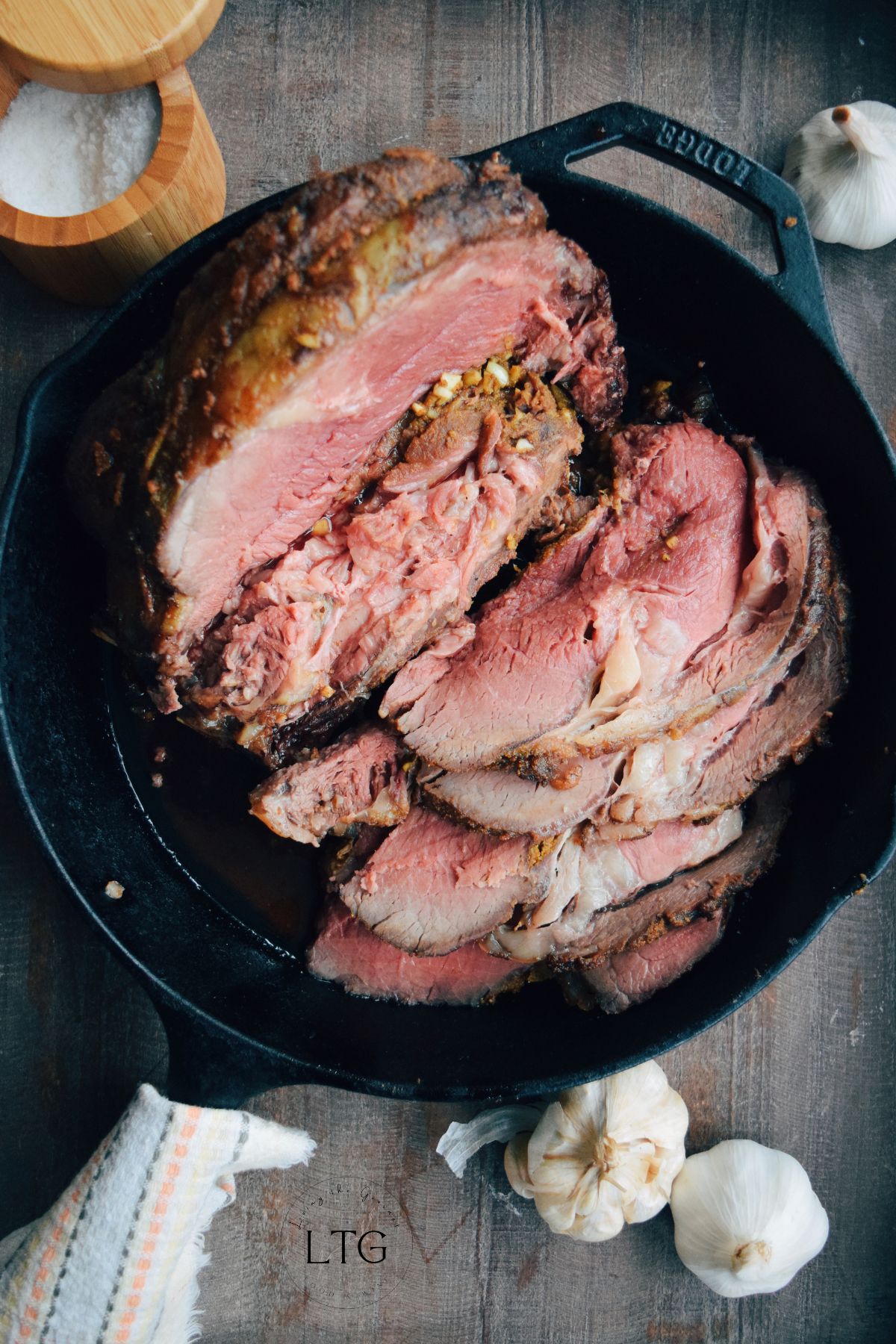
Kitchen Prep – Equipment You’ll Need
So you’ve got the right beef, and you’ve got the necessary ingredients. Now it’s time to make sure you’ve got the right tools to ensure even cooking, precise doneness, and effortless carving - because that's the basis of preparing a good Garlic and Herb Prime Rib recipe.
Here’s everything you’ll need:
Meat Thermometer – Crucial for Perfect Doneness
While guesswork and touch testing can certainly ensure a perfectly done roast, there’s really no stand-in for good meat thermometer or instant read thermometer. In my opinion, these tools are essential to achieving your desired level of doneness without guesswork. Because let’s be real, even the best chefs have ‘guessed wrong’ and produced either an undercooked roast that needs more cook time, or dried out a nice piece of meat by overcooking it. Let’s avoid that. Also, since prime rib continues to cook after being removed from the oven (we call this residual heat), monitoring the internal temperature after it’s left the oven ensures that you cook up a juicy, tender roast every time.
With that in mind, here are the temps to aim for based on your preference:
- Rare: 120–125°F
- Medium-Rare: 130–135°F (Recommended)
- Medium: 140–145°F
- Well-Done: 150°F+ (Not recommended for prime rib)
Tip: Insert the thermometer into the thickest part of the roast, away from the bone, for the most accurate reading.
Roasting Pan with Rack – Ensures Even Cooking
You can monitor the temperature all you like, but if the roast isn’t cooking evenly, it never had a chance to cook perfectly. A roasting pan with a rack allows for even heat circulation, thereby preventing the meat from sitting in its own juices and becoming soggy, while cooking the bottom faster than the top. Not good. Here’s how it works:
- The rack elevates the roast, ensuring the heat circulates evenly, while the juices collect at the bottom, perfect for making a rich pan sauce.
- A heavy-duty roasting pan helps maintain stable oven temperatures, preventing uneven cooking.
Tip: If you don’t have a rack, you can create a makeshift one by placing thickly sliced onions, carrots, and celery at the bottom of the pan—this adds flavor to the drippings!
Sharp Carving Knife – For the Perfect Slice
Okay, you’ve cooked the roast perfectly, and you’ve even allowed it time to rest (don’t skip the resting phase). Now it’s time for the final step – making the perfect cut. And to ensure the perfect cut, a sharp carving knife is crucial for clean, even slices that retain all the delicious juices.
- Long Knife: Preferably, you want to use a long slicing knife (preferably a granton-edge or hollow-edge knife) to ensure that you create even, thick slices without tearing or shredding the meat. Also, dull knives are more prone to kitchen accidents.
- Boning Knife: If you’re preparing a bone-in roast, you might consider using a boning knife, since these knives can help separate the meat from the bones before slicing.
Pro Tip: Always slice against the grain to ensure the tenderest slice possible.
videos you may enjoy
Tips for prepping your Garlic and Herb Prime Rib
Time for a recap. Here are some general tips and guidelines for success, to make you’re your roast comes out perfect every time.
Remember that while this recipe calls for a bone-in prime rib, all of the tips I’m about to give also apply to preparing a boneless rib roast as well. More than that, these tips can also be applied to things like a rack of lamb, a pork shoulder, or even a standing rib roast. Basically, any roast you might be serving for a nice dinner party or Christmas dinner.
With that said, here are some tips to help you achieve a delicious and perfectly cooked roast:
- Select a Quality Roast:
- Naturally, a delicious prime rib recipe starts with a top quality prime rib. I’ve talked about how to select top quality meat quite a bit here on Living the Gourmet, but the most important tip in this area that I can provide is to find a reputable butcher or a supplier that you can trust. Beyond that, look for well-marbled meat with a good fat cap, which enhances flavor and tenderness.
- Let it Rest:
- Do not try to roast cold meat. Instead, remove the roast from the refrigerator and let it sit at room temperature for about 1-2 hours before you start roasting. This promotes even cooking.
- Season Generously:
- The garlic herb crust is meant to be just that – a crust. That means it needs to be generously distributed over the entirety of the roast’s exterior. So, you want to season the roast generously, and for today’s recipe that means a nice, savory combination of herbs and garlic.
- Use a Meat Thermometer:
- I say this every time I talk about roasts, and here it is again. I wholeheartedly suggest investing in a good meat thermometer or instant-read thermometer. Simply insert it into the thickest part of the roast without touching the bone, and you get an accurate read on the meat’s temperature, no more guessing.
- Preheat the Oven:
- We start high and end low. That means preheating your oven to a high temperature, around 450-500°F (230-260°C). The reason we do this is to achieve a high heat sear on the exterior of the meat to lock in the juices.
- Brief High Heat:
- The high heat sear should only take about 15-30 minutes to create the exterior sear, and achieve a nice crust. Basically, the opposite of the reverse sear method.
- Lower Temperature:
- Once the high-heat sear is done, you want to reduce the oven temperature to around 325-350°F (160-180°C), and then continue roasting the prime rib until you’ve achieved your preferred level of doneness. See below for the temperature ranges for each level of doneness.
- Use a Roasting Pan:
- This is a big one. Using a roasting pan with a rack allows for even air circulation, which in turn helps the roast cook evenly. Even cooking means even doneness, which in turn results in a moist and tender roast. That said, cooking the roast in a pan or cast iron works just fine. As proof, you can see from the pictures that I’ve prepared mine in a large cast iron pan.
- Baste or Use a Drip Pan:
- Basting the roast with its juices, or using a drip pan with aromatics like garlic, fresh herbs, and onions, will work to not only enhance the flavor of the beef but to help keep it moist throughout roasting.
- Rest the Roast:
- Super important. Once the roast is done cooking, I cannot emphasize enough just how important it is to allow the roast to rest for at least 15-20 minutes. We do this because resting allows the juices to redistribute throughout the meat. If you skip this, it risks the beef juices leaking out of the meat upon slicing. Not good.
- Calculate the Cooking Time:
- A general guideline for cooking time is about 17-20 minutes per pound, but use a meat thermometer to gauge doneness accurately. The internal temperature should be 5-10°F (3-5°C) lower than your desired final temperature. More on temperatures below.
- Carve Carefully:
- Use a sharp knife. When carving the roast, follow the bone's contours to achieve even slices. A sharp carving knife is essential. Using a dull knife (or a knife that isn’t evenly sharp all along the blade) risks injury.
- Au Jus or Gravy:
- Use the pan drippings to create a delicious prime rib au jus sauce or gravy.
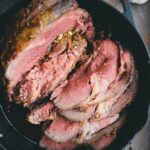
Perfect Prime Rib
- Total Time: 1 hour 30 minutes
- Yield: 6-8 1x
Ingredients
- 3 - 4 lb. Prime Rib
For the Rub:
- 1 tsp. Cayenne
- 1 tsp. Garlic Powder
- 1 tsp. Jamaican Curry
- 1 tsp. Cumin
- 1 tsp. Salt
- 1 tsp. Coriander
- 3 cloves of fresh garlic, chopped fine
- 3 tbs. olive oil
Instructions
- Preheat oven 325 degrees F.
- Combine all of the ingredients for the rub in a small bowl and mix.
- Place the prime rib into a large cast iron frying pan and make very small slits in the meat. Massage the meat with the prepared rub and fill the slits with the rub and garlic.
- Let the meat rest for 10 – 15 minutes before placing it in the oven, or wrap the meat in plastic wrap and place it in the refrigerator for one hour to overnight.
- A guide for cooking is usually 17 to 20 minutes per pound. It usually is best to go with the lesser time since the meat continues to cook for a time when it is removed from the oven.
- Let the roast rest for 15–20 minutes before carving.
- Best served with the natural juices from the roast that are found in the bottom of the pan.
- Prep Time: 10 minutes
- Cook Time: 1 hour 20 minutes
- Category: Main Dish
- Method: Roast
- Cuisine: American
Nutrition
- Serving Size: 1
That’s our Garlic Herb Prime Rib Recipe: Your Guide to a Perfect Roast. If you enjoyed today’s recipe, or have any questions or suggestions, be sure to let us know in the comments below, we always love hearing from you.
Happy Cooking!
4
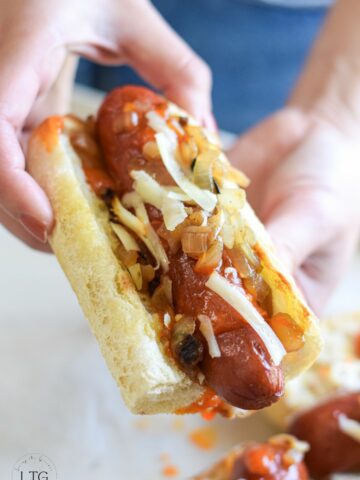
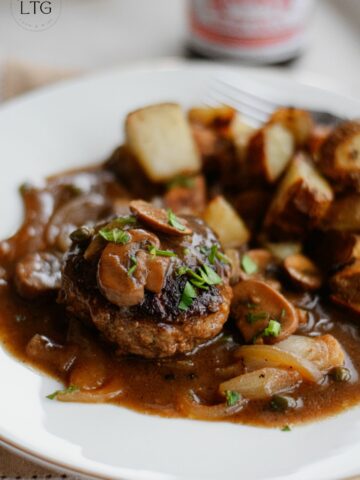
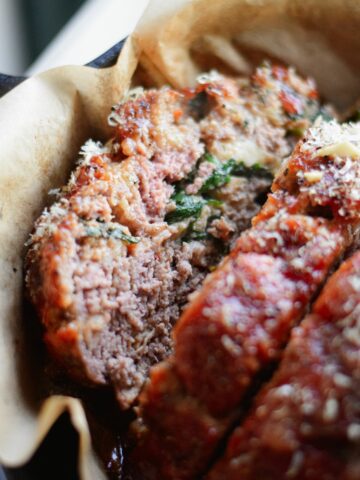
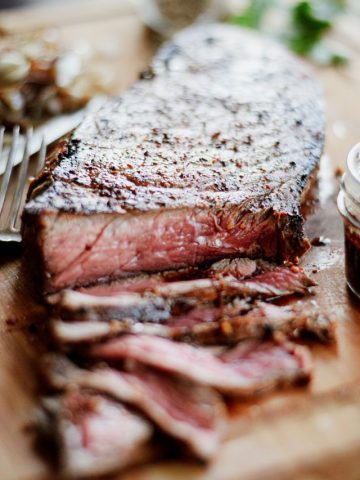
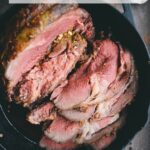
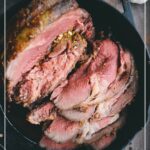
angiesrecipes says
Juicy tender and so yummy!
Astrid says
Amazing! I'd love to try this one of these days :).
Lisa says
I’m salivating over this prime rib dish! We’re constantly looking for new recipe ideas, and now I’ve found one. Definitely will be trying this one out!
MELANIE EDJOURIAN says
This sounds like a tasty recipe. I normally mainly make beef fillet rather than this sort of thing but it'll make a nice change.
Lisa says
woah, this looks amazing! I have always been unsure of how to use rubs, and have stuck with marinades. But this really clears it up for me. Thank you!!
DAVID J MYERS says
Catherine, Prime Rib is one of our (my) all time favorites! Never thought to rub it with Jamaican curry and cayenne though...although we like both of them. Add roasted potatoes, a nice simple salad and some yeasty rolls and this meal is hard to beat! (I haven't had the nerve to price out prime rib in the middle of the pandemic meat shortage...and resulting $ increases. Stay Safe and Take Care, Big Daddy Dave
Catherine Pappas says
Dear Dave, I love prime rib! I had this one in the freezer waiting to be used for a birthday celebration that did not happen due to the pandemic. I decided to spice it up a bit with the seasonings. Stay safe and well to you and Laurie.
Heather says
I love prime rib! It's one of those things that I never imagine myself making at home and usually order when we go out to eat.
Catherine Pappas says
It is fun to order prime rib out but I think it is even better at home! You get all the leftovers and get to prepare it the way you like it and even experimenting with flavors. I hope you like it if you give it a try. Stay well.
Sarah | Boo Roo and Tigger Too says
This looks delicious, perfect for summer outdoor eating in the garden
Catherine Pappas says
Thank you. It is perfect for summer and the leftovers make a great sandwich!
Yeah Lifestyle says
The prime rib look super delish! I did not know the difference between rub and marinade so that was good to know
Catherine Pappas says
Thank you and thank you for your kind comments.
Ashlee says
I learn so much on this site. I did not know about the smoke point with olive oil, but when I think about it, it makes so much sense! Also it's getting hotter and I love prime rib for summer!
Catherine Pappas says
Thank you for your kind comments. I love prime rib for summer too. Stay well.
Talya Stone says
Oh my goodness please can I dive right in and devour this? It looks so succulent and yummy!
Catherine Pappas says
Thank you for your kind comments. I wish I could share it with you. Stay well.
Monica says
Awesome recipe, and this pot - what is that? I've been looking for something like that for ages.
Catherine Pappas says
Thank you. The pan is a cast-iron frying pan that I cooked the prime rib in. It is the large size. I love cooking with cast iron. Cooking with cast iron makes everything better. Stay well.
Shannon Gurnee says
This looks like an amazing meal. I've not made Prime Rib before, but it looks delicious!
Catherine Pappas says
Thank you! It really is fun to make at home and enjoy, especially having the leftovers.
Jay Aguirre says
Oh wow, my mouth is watering so bad. I was in Argentina before coronavirus sent me home and was having steak nearly every day. I've been missing it so I might have to treat myself to this recipe soon!
Catherine Pappas says
Oh, I hope you enjoy it if you give it a try. I love steak too! Stay well.
Melanie williams says
My other half will love this. He loves a good prime rib and this would be perfect for his movie nights x
Catherine Pappas says
Oh, I hope he enjoys it if you give it a try. It is perfect for movie night! Stay well.